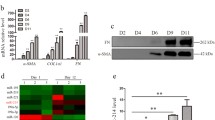Abstract
In our previous studies, we identified miR-16 as being downregulated during activation of hepatic stellate cells (HSCs) by microarray hybridization. However, the roles and related mechanisms of miR-16 in HSCs are not understood. In this study, The miRNA RNAi technique was used to analyze the effects of miR-16 on biological properties of HSCs in vitro. The lentiviral vector encoding miR-16 was constructed and transfected. Furthermore, the expression level of miR-16 was measured by real-time PCR. Cellular growth and proliferation capacity were assayed using the cell counting kit-8 (CCK-8). The apoptosis rate and cell-cycle distribution were measured by flow cytometry. Cell morphological characteristics were identified by phase-contrast microscopy, fluorescence microscopy and electron microscopy. The underlying mechanisms related to the changes in biological properties were assessed. The identity of the recombinant plasmid was confirmed by restriction endonuclease analysis and DNA sequencing. Virus titer was 108 > ifu/m. Restoring the intracellular miRNAs by miR-16 administration greatly reduced the expression levels of cyclin D1 (CD1). Cell-cycle arrest and typical features of apoptosis were detected in activated HSCs treated with pLV-miR-16. Our results indicate that transduction of miR-16 offers a feasible approach to significantly inhibit HSC proliferation and increase the apoptosis index. Thus, targeted transfer of miR-16 into HSC may be useful for the treatment of hepatic fibrosis.






Similar content being viewed by others
Abbreviations
- miRNA:
-
microRNA
- HSC:
-
Hepatic stellate cell
- 3′UTR:
-
3′untranslated region
- SD:
-
Standard deviation
- CCK-8:
-
Cell counting kit-8
- CD1:
-
Cyclin D1
References
Sprenger H, Kaufmann A, Garn H, Lahme B, Gemsa D, Gressner AM (1997) Induction of neutrophil-attracting chemokines in transforming rat hepatic stellate cells. Gastroenterology 113:277–285
Kruglov EA, Correa PR, Arora G, Yu J, Nathanson MH, Dranoff JA (2007) Molecular basis for calcium signaling in hepatic stellate cells. Am J Physiol Gastrointest Liver Physiol 292:G975–G982
Novo E, Marra F, Zamara E, Valfrè di Bonzo L, Monitillo L, Cannito S et al (2006) Overexpression of Bcl-2 by activatedhumanhepatic stellate cells: resistance to apoptosis as a mechanism of progressive hepatic fibrogenesis in humans. Gut 55:1174–1182
Kawada N (2006) Human hepatic stellate cells are resistant to apoptosis: implications for human fibrogenic liver disease. Gut 55:1073–1074
Lin YL, Lee TF, Huang YJ, Huang YT (2006) Antiproliferative effect of salvianolic acid A on rat hepatic stellate cells. J Pharm Pharmacol 58:933–939
Chitwood DH, Timmermans MC (2007) Target mimics modulate miRNAs. Nat Genet 39:935–936
Ambros V (2004) The functions of animal miRNA. Nature 431:350–355
Guo CJ, Pan Q, Li DG, Sun H, Liu BW (2009) miR-15b and miR-16 are implicated in activation of the rat hepatic stellate cell: an essential role for apoptosis. J Hepatol 50:766–778
Guo CJ, Pan Q, Cheng T, Jiang B, Chen GY, Li DG (2009) Changes in microRNAs associated with hepatic stellate cell activation status identify signaling pathways. FEBS J 276:5163–5176
Friedman SL, Roll FJ (1987) Isolation and culture of hepatic lipocytes, Kupffer cells, and sinusoidal endothelial cells by density gradient centrifugation with Stractan. Anal Biochem 161:207–218
Ying-Bin Hu, Ding-Guo Li, Han-Ming Lu (2007) Modified synthetic siRNA targeting tissue inhibitor of metalloproteinase-2 inhibits hepatic fibrogenesis in rats. J Gene Med 9:217–229
Chen C, Ridzon DA, Broomer AJ, Zhou Z, Lee DH, Nguyen JT et al (2005) Real-time quantification of microRNAs by stem-loop RTPCR. Nucleic Acids Res 33:e179
Livak KJ, Schmittgen TD (2001) Analysis of relative gene expression data using real-time quantitative PCR and the 2(-Delta Delta C(T)) method. Methods 25:402–408
Mraz M, Pospisilova S, Malinova K, Slapak I, Mayer J (2009) MicroRNAs in chronic lymphocytic leukemia pathogenesis and disease subtypes. Leuk Lymphoma 50:506–509
Raveche ES, Salerno E, Scaglione BJ et al (2007) Abnormal microRNA-16 locus with synteny to human 13q14 linked to CLL in NZB mice. Blood 109:5079–5086
Bottoni A, Piccin D, Tagliati F, Luchin A, Zatelli MC, degli Uberti EC (2005) miR-15a and miR-16-1 down-regulation in pituitary adenomas. J Cell Physiol 204:280–285
Bandi N, Zbinden S, Gugger M et al (2009) miR-15a and miR-16 are implicated in cell cycle regulation in a Rb-dependent manner and are frequently deleted or down-regulated in non-small cell lung cancer. Cancer Res 69:5553–5559
Bonci D, Coppola V, Musumeci M et al (2008) The miR-15a-miR-16-1 cluster controls prostate cancer by targeting multiple oncogenic activities. Nat Med 14:1271–1277
Linsley PS, Schelter J, Burchard J et al (2007) Transcripts targeted by the microRNA-16 family cooperatively regulate cell cycle progression. Mol Cell Biol 27:2240–2252
Kim MR, Kim HS, Lee MS, Lee MJ, Jang JJ (2005) Cell cycle protein profile of the hepatic stellate cells (HSCs) in dimethylnitrosamine-induced rat hepatic fibrosis. Exp Mol Med 37:335–342
Dudas J, Saile B, El-Armouche H, Aprigliano I, Ramadori G (2003) Endoreplication and polyploidy in primary culture of rat hepatic stellate cells. Cell Tissue Res 313:301–311
Chen MH, Chen SH, Wang QF et al (2008) The molecular mechanism of gypenosides-induced G1 growth arrest of rat hepatic stellate cells. J Ethnopharmacol 117:309–317
Chen RW, Bemis LT, Amato CM et al (2008) Truncation in CCND1 mRNA alters miR-16-1 regulation in mantle cell lymphoma. Blood 112:822–829
Liu Q, Fu H, Sun F et al (2008) miR-16 family induces cell cycle arrest by regulating multiple cell cycle genes. Nucleic Acids Res 36:5391–5404
Stenvang J, Kauppinen S (2008) MicroRNAs as targets for antisense-based therapeutics. Expert Opin Biol Ther 8:59–81
Acknowledgements
This work is supported by the Foundation of Shanghai Commission of Science Technology of Research Program (O7JC14044).
Author information
Authors and Affiliations
Corresponding authors
Rights and permissions
About this article
Cite this article
Guo, CJ., Pan, Q., Jiang, B. et al. Effects of upregulated expression of microRNA-16 on biological properties of culture-activated hepatic stellate cells. Apoptosis 14, 1331–1340 (2009). https://doi.org/10.1007/s10495-009-0401-3
Published:
Issue Date:
DOI: https://doi.org/10.1007/s10495-009-0401-3




